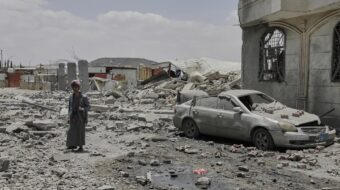The Victims of Communism Memorial at the intersection of New Jersey and Massachusetts Avenues NW in Washington, D.C., was finally unveiled, June 12. It’s a small, 10-foot bronze replica of the “Goddess of Democracy” carried around by Chinese students who protested in Tiananmen Square in 1989.
The Washington Post, in “The Meaning of a Marker for 100 Million Victims” (June 13), editorializes, “If one were to build monuments commensurate in size to the atrocities they memorialize, the victims of communism would require perhaps the entirety of the federal city.” At least that’s according to numbers given by those who spoke at the dedication, who repeatedly claimed 100 million persons killed.
The Post finds it odd that the more than 400,000 Americans killed in the Second World War merits “a huge plaza of fascistic grandiloquence,” and that the 58,000 killed in the Vietnam War “are honored not just by an eloquent memorial and some tacky statuary but will soon be given a third monumental structure on the Mall,” while, at the same time, “the 100 million victims of communism get only a street-corner marker.”
However, comparing what happened in World War II and Indochina with what happened under communism, the relative size of the memorials is about right. This is not to say that bad things didn’t happen under socialism; it is to say that what happened under socialism doesn’t hold a candle to what has occurred under capitalism.
Capitalists reduced the indigenous population in North America (not including Mexico) by over 90 percent — from 14 million human beings, when Europeans first landed on the continent, to fewer than 300,000 by the end of the 19th century. In the Caribbean and South America, the devastation wrought by capitalism was probably six to eight times greater.
Capitalists killed and enslaved tens of millions of Africans and plundered the continent. The capitalist wars of the 20th century killed tens of millions of people around the globe. The death toll from World War II alone was around 50 million, the largest numbers of which were working people defending the Soviet Union.
Fatalities caused by U.S. armed forces or U.S.-backed surrogate forces in the second half of the 20th century amount to approximately 3 million in Vietnam, 1 million in Cambodia, 1 million in Mozambique, 500,000 to 1 million in Indonesia, 600,000 in Angola, 300,000 in Laos, 250,000 in East Timor, 200,000 in Iraq (the first time around), 200,000 in Afghanistan (the first time around), 150,000 in Guatemala, 100,000 in Nicaragua, 90,000 in El Salvador and tens of thousands in Chile, Argentina, Zaire, Iran, Colombia, Bolivia, Brazil, Panama, Somalia, South Yemen, Western Sahara and so on. (These are the figures Michael Parenti produces in his wonderful little book, “Dirty Truths.”)
What will the toll be after the U.S. and British armies leave Iraq? Including the consequences of economic sanctions following the first Gulf War, the number of deaths in Iraq caused by the capitalist West over the last decade is easily over 2 million. How many will die after the westerners leave because of the conditions the capitalists established while there? How many more will die in Afghanistan, Pakistan and Palestine? If the past is any indication, the numbers will be horrific. The conflicts being cultivated around the world are the work of global capitalism.
Whereas socialism provided an adequate life for all of its citizens, capitalism has always systemically failed to meet the basic needs of people. Children starve to death because capitalist markets cannot adequately distribute food to those who are hungry. Children die from disease because privately owned health care institutions and pharmaceutical companies refuse to treat those who cannot pay. Workers die from unsafe working conditions and their families are sickened by environmental pollution.
Where is the memorial to these victims? The entirety of what city would be required for a monument to the victims of capitalism?
There’s no city big enough.
Andrew Austin (austina@uwgb.edu) is associate professor of social change and development and chair of the Sociology Department at the University of Wisconsin-Green Bay.









